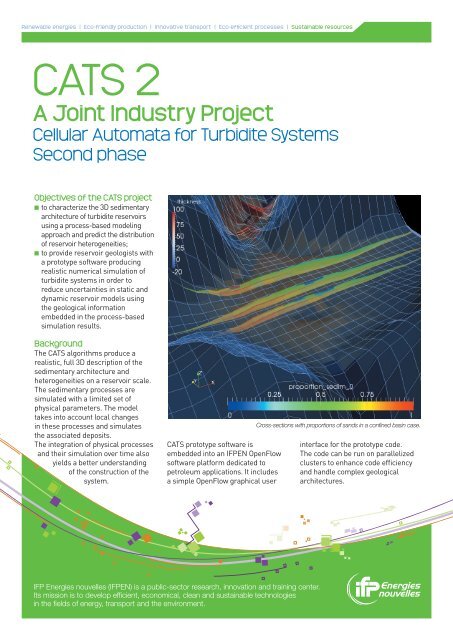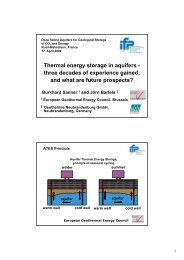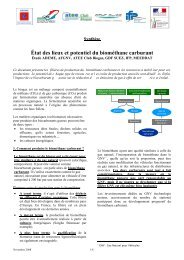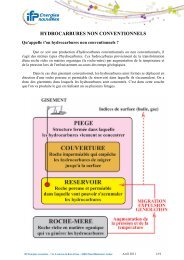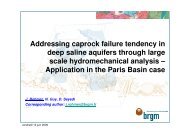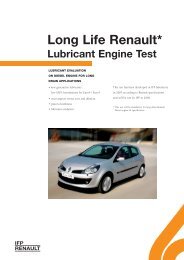JIP-Cats 2 - IFP Energies nouvelles
JIP-Cats 2 - IFP Energies nouvelles
JIP-Cats 2 - IFP Energies nouvelles
Create successful ePaper yourself
Turn your PDF publications into a flip-book with our unique Google optimized e-Paper software.
Renewable energies | Eco-friendly production | Innovative transport | Eco-efficient processes | Sustainable resources<br />
CATS 2<br />
A Joint Industry Project<br />
Cellular Automata for Turbidite Systems<br />
Second phase<br />
Objectives of the CATS project<br />
n to characterize the 3D sedimentary<br />
architecture of turbidite reservoirs<br />
using a process-based modeling<br />
approach and predict the distribution<br />
of reservoir heterogeneities;<br />
n to provide reservoir geologists with<br />
a prototype software producing<br />
realistic numerical simulation of<br />
turbidite systems in order to<br />
reduce uncertainties in static and<br />
dynamic reservoir models using<br />
the geological information<br />
embedded in the process-based<br />
simulation results.<br />
Background<br />
The CATS algorithms produce a<br />
realistic, full 3D description of the<br />
sedimentary architecture and<br />
heterogeneities on a reservoir scale.<br />
The sedimentary processes are<br />
simulated with a limited set of<br />
physical parameters. The model<br />
takes into account local changes<br />
in these processes and simulates<br />
the associated deposits.<br />
The integration of physical processes<br />
and their simulation over time also<br />
yields a better understanding<br />
of the construction of the<br />
system.<br />
CATS prototype software is<br />
embedded into an <strong>IFP</strong>EN OpenFlow<br />
software platform dedicated to<br />
petroleum applications. It includes<br />
a simple OpenFlow graphical user<br />
<strong>IFP</strong> <strong>Energies</strong> <strong>nouvelles</strong> (<strong>IFP</strong>EN) is a public-sector research, innovation and training center.<br />
Its mission is to develop efficient, economical, clean and sustainable technologies<br />
in the fields of energy, transport and the environment.<br />
Cross-sections with proportions of sands in a confined basin case.<br />
interface for the prototype code.<br />
The code can be run on parallelized<br />
clusters to enhance code efficiency<br />
and handle complex geological<br />
architectures.
CATS 2 objectives<br />
The second phase of the <strong>JIP</strong><br />
(CATS 2) aims to extend the<br />
capabilities of the CATS model:<br />
new features for the physical model,<br />
various improvements made to<br />
the prototype, assessment of<br />
uncertainties. Moreover,<br />
comparison with analogical<br />
and numerical models and<br />
calibration based on real-case<br />
data will be provided.<br />
Technical Program<br />
The proposed technical program for<br />
the CATS 2 consortium has been<br />
designed on the basis of the wishes<br />
of the partners in the first CATS <strong>JIP</strong>,<br />
as well as identified new partners.<br />
It is divided into three work<br />
packages (WP):<br />
WP1: Physical model evolution<br />
n improve coupling between the<br />
current processes implemented;<br />
n implement a cellular automata<br />
module for granular flow physics;<br />
n couple granular physics with<br />
turbulent physics;<br />
n additional process: mud<br />
decantation between turbidite<br />
events.<br />
WP2: Prototype improvements and<br />
new functionalities<br />
n input a spatially heterogeneous<br />
substratum using an input map of<br />
lithology proportions;<br />
n launch a new simulation from a<br />
given CATS-simulated result;<br />
n optimize the parallel computing<br />
capabilities.<br />
WP3: Multi-realizations and<br />
uncertainty<br />
n generate multi-realizations taking<br />
into account uncertainty on flow<br />
parameters and topography.<br />
The information contained in this document is not contractual<br />
<strong>IFP</strong> <strong>Energies</strong> <strong>nouvelles</strong> – Resources Business Unit<br />
resources@ifpen.fr<br />
<strong>IFP</strong> <strong>Energies</strong> <strong>nouvelles</strong><br />
1 et 4, avenue de Bois-Préau<br />
92852 Rueil-Malmaison Cedex – France<br />
Tel.: +33 1 47 52 60 00 – Fax: +33 1 47 52 70 00<br />
<strong>IFP</strong> <strong>Energies</strong> <strong>nouvelles</strong>-Lyon<br />
Rond-point de l’échangeur de Solaize<br />
BP 3 – 69360 Solaize – France<br />
Tel.: +33 4 37 70 20 00<br />
www.ifpenergies<strong>nouvelles</strong>.com<br />
Sand and silt deposits from a multi-event simulation on a synthetic topography<br />
with a sinuous channel and downstream unconfined area.<br />
Deliverables<br />
Year 1<br />
n prototype software for turbulent<br />
turbidite flow models (Version 4),<br />
including:<br />
• model improvements, with the<br />
possibility of inputting a<br />
heterogeneous initial map for<br />
bed composition;<br />
• possibility of using a previous<br />
CATS result as the initial point<br />
for a new simulation.<br />
Year 2<br />
n CATS prototype software<br />
(Version 5), including:<br />
• optimization for faster<br />
computing in both sequential<br />
and parallel modes;<br />
• a turbulent turbidite flow model<br />
and a granular flow module;<br />
• mud decantation between<br />
turbiditic events.<br />
Year 3<br />
n CATS prototype software<br />
(Version 6), including coupled<br />
granular and turbulent turbidite<br />
flows, with associated erosion<br />
and deposition processes;<br />
n report on CATS model tests;<br />
n report describing the<br />
methodology used to incorporate<br />
and assess uncertainty on flow<br />
parameters and topography.<br />
Project organization<br />
The program is scheduled to last<br />
three years. Two workshops per<br />
year will be held to present<br />
progress reports and trigger<br />
discussion with partners relative<br />
to future strategy. Users’ meetings<br />
will also be organized, for both<br />
technical discussion and the<br />
collection of feedback.<br />
New versions of the CATS prototype<br />
will be released at the end of each<br />
year of work and will include the<br />
latest validated improvements and<br />
implementations.<br />
<strong>JIP</strong> Leader<br />
Vanessa Teles<br />
vanessa.teles@ifpen.fr<br />
Tel.: +33 1 47 52 57 26<br />
Fax: +33 1 47 52 71 26<br />
Institutional Relations and Communications Division - 021209 - Photos: ©<strong>IFP</strong>EN, X - Document printed on 100% FSC-certified paper, partially recycled in a printing plant with the Imprim’Vert green printing label


